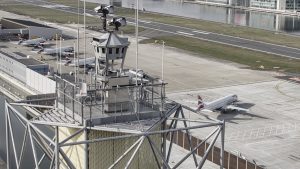Saab makes London City Airport the first major British operator of long-haul air traffic control
 Technology from Saab Digital Air Traffic Solutions has enabled London City Airport to become the first major international airport in the world to be fully controlled by a digital tower for remote air traffic control.
Technology from Saab Digital Air Traffic Solutions has enabled London City Airport to become the first major international airport in the world to be fully controlled by a digital tower for remote air traffic control.
Saab’s Digital Tower is an air traffic control system that significantly improves air traffic controllers’ perception of the situation. This enables fast and well-informed decisions that promote safety and operational efficiency. Digital Tower has also enabled London City Airport to expand its business area, thanks to the increased coverage. This allows the airport to maximize its air traffic capacity.
The technology means that air traffic controllers can see increased levels of information on digital window screens. This includes identifying flight and radar data, the ability to zoom in and out, and additional graphics and enhancements that increase visibility. These functions can be used via control rooms located in another location.
At London City Airport, 16 high-resolution cameras and sensors record a 360-degree view of the airfield. The data is then transmitted through a high-speed fibre connection to a control room at the NATS Air Traffic Control Centre, which is 130km away in Swanwick, Hampshire. A dedicated team of air traffic controllers uses the live images, an airfield audio channel and radar readings to guide the aircraft to and from the airport.
“This is an important milestone for Saab in the introduction of solutions for long-distance air traffic control at large civil aviation centers with dense traffic in a complex airspace. We look forward to the technology being introduced at London City Airport and giving air traffic controllers new tools and safety features that demonstrate the benefits of Digital Tower,” says Magnus Lewis-Olsson, President and CEO of Saab UK.
“We are extremely proud to be the first major international airport to use this groundbreaking technology from Saab. The investment in smart infrastructure will help us meet the increased passenger flows of the future, improve air traffic control and give us future capacity when the aviation industry returns after the pandemic,” says Alison FitzGerald, Chief Operating Officer at London City Airport.
Digital Tower is a flexible and scalable solution for a large number of civilian and military applications. The system has already been successfully introduced at airports in Sweden, the United Kingdom, the Netherlands, Germany and the United States, at the same time as it was selected by the Royal Navy for their naval airports in the United Kingdom.
Video from the digital air traffic control tower at London City Airport is available here: https://saab.screen9.tv/














